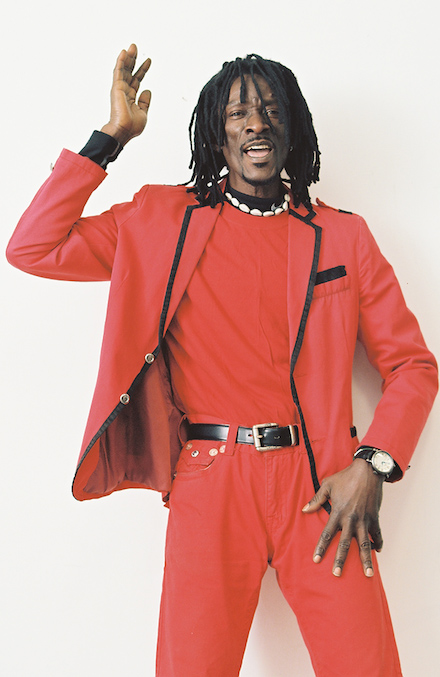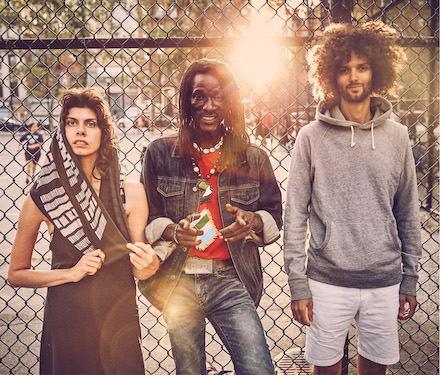(NORTH ADAMS, Mass.) — Sierra Leonean singer Janka Nabay brings his modern update of Bubu – an ancient Sierra Leonean call-and-response style of folk music influenced by the 18th-century regional introduction of Islam – to Club B-10 at MASS MoCA on Saturday, March 11, at 8pm. With the help of his group, the Bubu Gang, Nabay turns this 500-year-old roots music into a frenetic, hypnotic, funky dance music with flourishes of electronica.
A native of Sierra Leone, Nabay enjoyed widespread popularity with his Bubu music that incorporated traditional bamboo flutes and metal pipes with electronic instrumentation in the first instances of recorded Bubu music. When civil war broke out in Sierra Leone, Nabay used his music to speak out against the spiraling violence, but when it was co-opted by rebels during their campaigns of destruction through rural villages, Nabay left his homeland behind and sought refuge in the United States.
After an embattled musical stint in Washington D.C., Nabay took to local stages throughout New York City, inspiring an eclectic group of musicians to fall in love with his frenetic style of Bubu-infused dance music. “We speak one language now,” Nabay says of collaborating with stars of the Brooklyn indie-rock scene who make up the Bubu Gang. A full band, comprised of members of stalwart New York bands Chairlift, Skeletons, Highlife, and Saadi, grew out of his spreading popularity.
In 2012, the band signed to David Byrne’s label Luaka Bop, releasing “En Yah Say” that year. The label has just announced a new album in 2017, “Build Music,” that is more studio-focused, further bringing electronic and modern influences to the fore. Since Janka Nabay and the Bubu Gang’s first performances in 2010, the group has been infusing polyrhythmic folk tunes with high-octane psychedelia in shows characterized as “…the beat, fast and skeletal and driven by bell taps, was unstoppable, demanding wider dissemination” (New York Times).
While Nabay has evolved into a bandleader and MC in the tradition of James Brown and Fela Kuti, his polycultural sound draws as much from Nabay’s traditional Bubu as it does from the sunny energy of Ghanaian highlife, the extended improvisations of 1970s Miles Davis, the hypnotic rhythms of classic Afrobeat, and the swirling shredding guitars of 1960s and ‘70s psychedelia.
“Build Music, “Nabay’s second album for Luaka Bop, embodies the conflicted nature of his own life as a musician in the United States. He considers himself — at the same time — a spokesperson for the ancient Bubu music of his Sierra Leonean homeland, and a self-described “black cowboy” on a trans-Atlantic mission to sculpt his futuristic music with the mindset of a revolutionary artist.
Sung in Sierra Leone’s lingua franca, Krio, his native tribal Temne, as well as English and bits of Arabic, Nabay’s songs sound infectious, inventive, and entertaining on the surface. But a listen with the translations of Nabay’s lyrics in hand reveals complex layers of meaning and discontent. “Game Over” expresses a strange mixture of hope and despair. “Santa Monica” is a joyous affirmation that relates a traumatic story of being harassed by the Santa Monica police just prior to his performance at The Getty Museum. Others are drunken calls to celebrate (“Popeneh”), self-reflexive songs about the power of songwriting itself (“Build Music”), love songs (“Stop Jealous”), and pleas for social cohesion (“Combination”).
Bubu has its roots in the call-and response traditional music of pre-Islamic Sierra Leone, and was later repurposed into a religious music used to celebrate Iftar (the breaking of daytime fast during the holy month of Ramadan). In the mid-1990s, Janka was the first musician to record Bubu music by reworking the traditional bamboo flutes and metal pipes with electronic instrumentation. Today, and with the backing of his Bubu Gang, Janka’s music has become a potent mind meld of off-kilter polyrhythmic folk tunes and high-octane psychedelia – not so different from the sound of early-1980s Talking Heads. It’s not surprising that David Byrne heard Nabay and signed him to his label.
Lickety Split, MASS MoCA’s café, serves up crisp salads, hearty soups, and lip-smacking pub fare before the seated theater show. A full bar serves Bright Ideas Brewing beers and Berkshire Mountain Distillery spirits throughout the performance. Tickets are $10 for students, $16 advance, $22 day of, and $28 preferred. Tickets for all events are available through the MASS MoCA box office located on Marshall Street in North Adams, open 11am to 5pm every day except Tuesdays. Tickets can also be charged by phone by calling 413.662.2111 during box office hours or purchased online at MASS MoCA.
About MASS MoCA
MASS MoCA is one of the world’s liveliest (and largest) centers for making, displaying, and enjoying today’s most important art, music, dance, theater, film, and video. MASS MoCA will nearly double its gallery space in spring 2017, with artist partnerships that include Laurie Anderson, the Louise Bourgeois Trust, Jenny Holzer, the Robert Rauschenberg Foundation, and James Turrell.
Gallery admission is $18 for adults, $16 for veterans and seniors, $12 for students, $8 for children 6 to 16, and free for children 5 and under, through May 21, 2017. Members are admitted free year-round. The Hall Art Foundation’s Anselm Kiefer exhibition is open seasonally, spring–fall. For additional information, call 413.662.2111 x1 or visit MASS MoCA.
Hours: 11am to 5pm, closed Tuesdays


